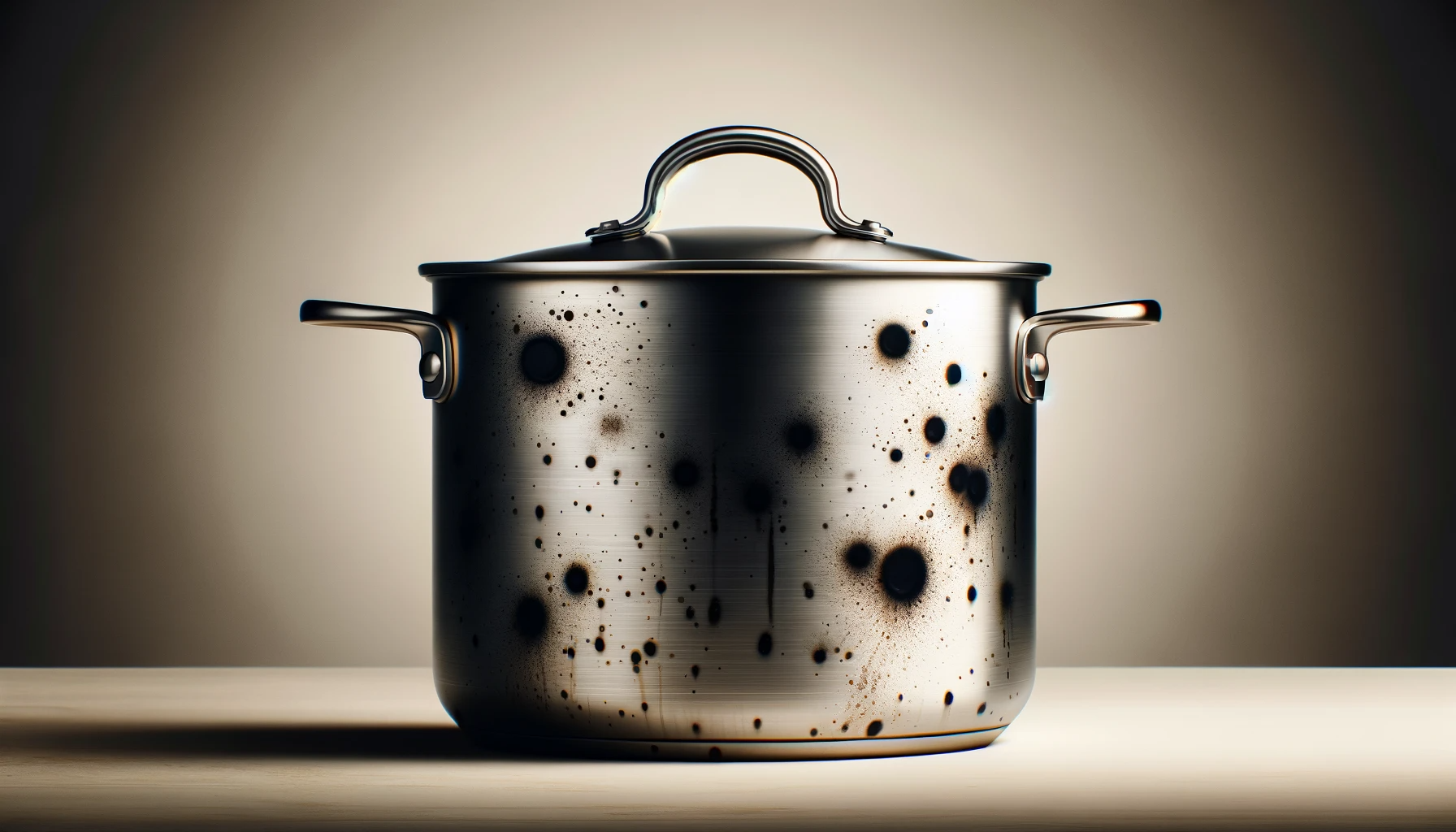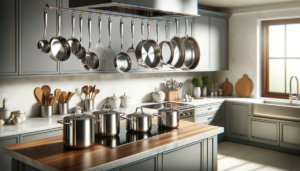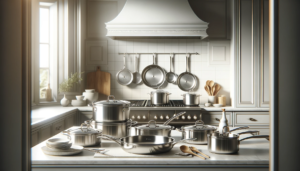That frustrating dotted black staining on your stainless steel pots and pans destroys the modern, gleaming look. Where do these stubborn spots come from when stainless steel should resist corrosion?
The causes of bothersome black spots actually stem from just a few preventable sources of surface damage over time.
Let’s dive into the main offenders behind black spotted cookware and how to dodge this common cooking dilemma…
What Causes Black Spots on Stainless Steel Cookware
The most common causes of black spots on stainless steel cookware are metal transfer from utensils, mineral deposits from water and food, overheating, and damage from abrasive cleaning.
These factors break down the protective chromium oxide surface layer over time leading to oxidation and corrosion when the underlying steel is exposed. Proper cooking methods and avoiding abrasives preserves this protective layer and prevents discoloration.
Let’s explore the main causes in depth and how you can keep your stainless steel pots and pans free of black spotted wear and tear…
1. Metal Transfer from Utensils
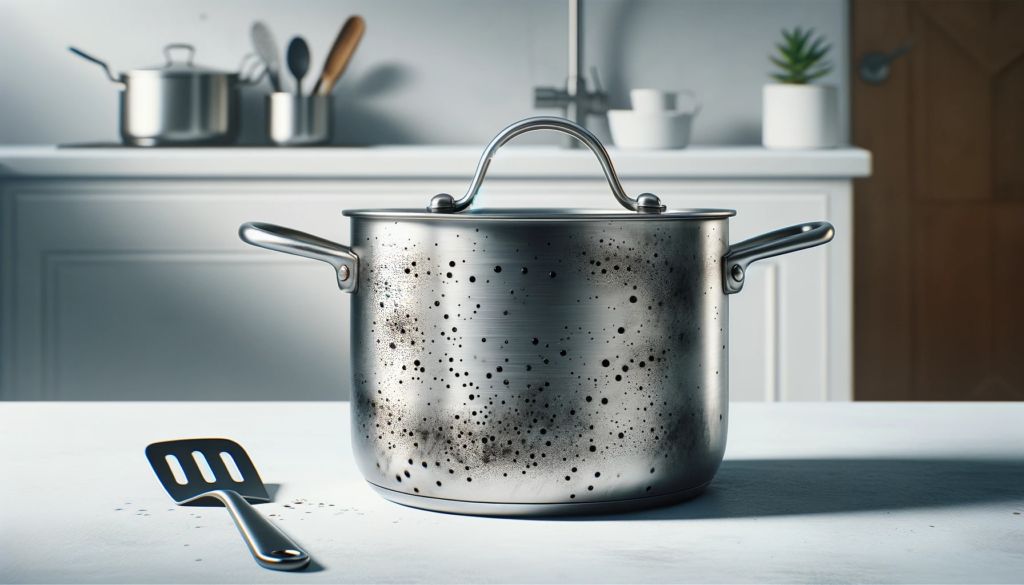
Using and storing pans with metal utensils can transfer bits of the metal onto the surface of the stainless steel. The most common types of metal that get transferred are from cast iron and carbon steel utensils.
When these small bits of transferred metal bond to the surface of the stainless steel, they can oxidize over time with exposure to air and moisture. This oxidation causes the formation of black spots and stains on the cookware.
There are a few reasons that metal transfer occurs more easily with cast iron and carbon steel utensils. First, these metals are more porous and softer compared to stainless steel.
Tiny fragments can break off into food or scrape onto the surface of the stainless steel. Second, if the utensils are abrasive from use over time, they can grind off tiny fragments of metal that embed in scratches on the surface.
Finally, differences in the thermal expansion of the metals can cause the utensil material to detach and transfer when heated.
To prevent metal transfer, it is best to use non-metal, silicone, wood, or plastic utensils when cooking with stainless steel pans. Storing cookware with other metal bakeware or utensils touching the surface should also be avoided to prevent transfer.
Any visible metal marks from utensils should be cleaned off with a non-abrasive cleaner as soon as possible.
Why Metal Transfers More Easily from Cast Iron and Carbon Steel
Cast iron and carbon steel are excellent conductors of heat, making them very popular pan and utensil materials. However, neither material has the anti-corrosive properties of stainless steel.
Tiny fragments can break off into food or scrape onto stainless steel surfaces when used due to cast iron and carbon steel being more porous and softer compared to stainless steel. This metal transfer issue is compounded when the utensils themselves become more abrasive through heavy use over time.
The rougher surface and microscopic imperfections in older used metal utensils make it easier for tiny fragments to grind off. These fragments become embedded in existing scratches or can create fresh new scratches themselves on stainless steel surfaces.
Differences in the rates of thermal expansion between cast iron/carbon steel and stainless steel are also a key factor. As cookware and utensils heat up, the metals expand at their own pace based on composition.
When rapidly heated or cooled, the difference in expansion rates can fracture microscopic fragments of material off a utensil. These fragments are more likely to transfer to the cookware surface they are contacting.
How to Prevent Metal Transfer
Using non-metal utensils is the easiest way to avoid any metal transfer issues when cooking with stainless steel pots and pans. Silicone, wood, plastic, and other polymer-based utensils will not contribute any metal material fragments regardless of relative thermal expansion differences.
Metal bakeware and accessories should also be kept isolated from direct contact with stainless steel cookware surfaces when being stored. Any visible marks or scratches that may contain traces of metal should be cleaned as soon as possible using a non-abrasive cleaner.
Doing so prevents further oxidation and black spot formation over time. Harsher abrasives could damage the stainless steel finish further and exacerbate the metal marking.
2. Mineral Deposits from Water or Food
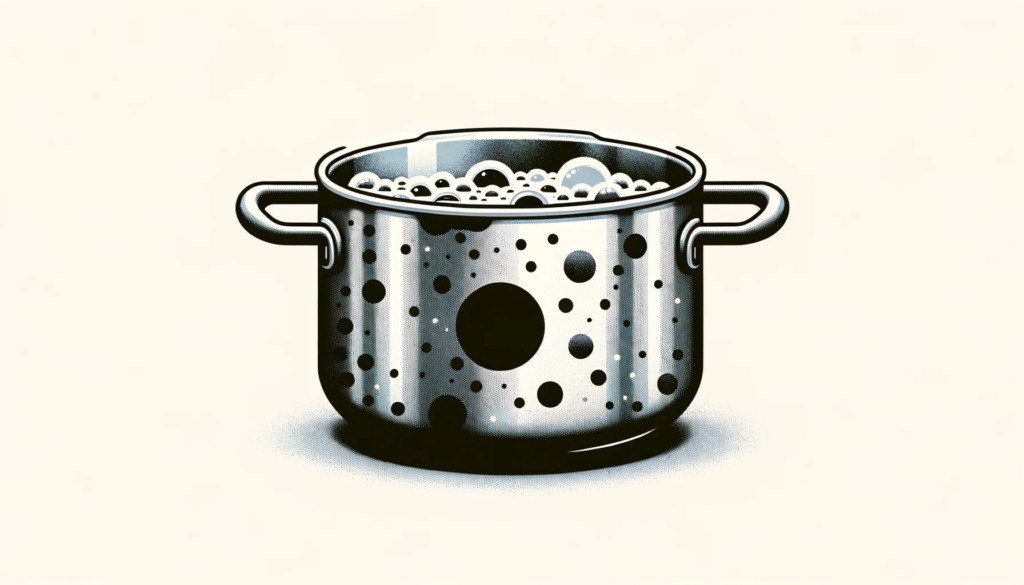
Hard water contains dissolved minerals like calcium, magnesium, and iron. As hard water evaporates inside or on the surface of stainless steel cookware, it leaves behind trace deposits of these minerals.
Foods cooked in hard water or those naturally high in minerals like iron can have the same effect over time. For example, boiling pasta or steaming vegetables repeatedly adds more and more invisible mineral content onto the cookware surface each time.
If these mineral deposits are left to build up, they can begin to oxidize in the presence of air and moisture, much like the metal transfer deposits. This oxidation causes black and brown discoloration, spots, and stains.
Foods that are acidic like tomatoes can speed up the oxidation process by interacting with the minerals, especially iron.
To prevent mineral deposits, it is important to clean stainless steel cookware thoroughly after cooking any food, especially in hard water areas. A vinegar water solution can help dissolve some mineral buildup.
Installation of a water softener can also minimize hard water mineral content for the whole home. Avoiding excessive boiling or steaming of foods high in iron and other minerals can as well.
How Hard Water Leads to Mineral Deposits
Water described as hard contains high dissolved concentrations of certain metal ions like calcium, magnesium, iron and manganese. The level of hardness is typically reported in grains per gallon, indicating the calcium and magnesium content.
The higher the grains per gallon measure, the more mineral deposits are left behind when water sources evaporate or dry out. This leads to a gradual buildup of mineral residue on surfaces the hard water contacts like stainless steel cookware.
The most common way hard mineral deposits occur is when droplets of water are left to dry on the inside or outside of pots and pans. The invisible dissolved minerals become more concentrated as the water evaporates, eventually reaching saturation.
These saturated mineral salts form microscopic granular deposits on the cookware that build up slowly with repeated exposure. Any food residues present can also bind minerals and accelerate deposit formation even faster.
Preventing Damage from Mineral Deposits
To prevent mineral deposit damage, timely cleaning of stainless steel cookware after each use is critical, especially with hard water sources. Any droplets or film should be wiped dry instead of allowed to air dry.
Using distilled white vinegar diluted with some water is also a simple way to help dissolve some mineralization build up when needed. For extreme hard water situations, installing a home water softener can be useful to remove excess minerals systemwide.
When cooking foods known to be rich in iron and minerals, try to avoid boiling or steaming methods which could concentrate deposits faster from the evaporating water. Opt for sautéing, pan frying or baking instead.
Routinely inspecting cookware under bright light can also reveal any stubborn mineral spots that may need more intensive cleaning before permanent staining occurs when the deposits oxidize extensively. Catching this mineral damage early makes removal much easier.
3. Overheating the Cookware
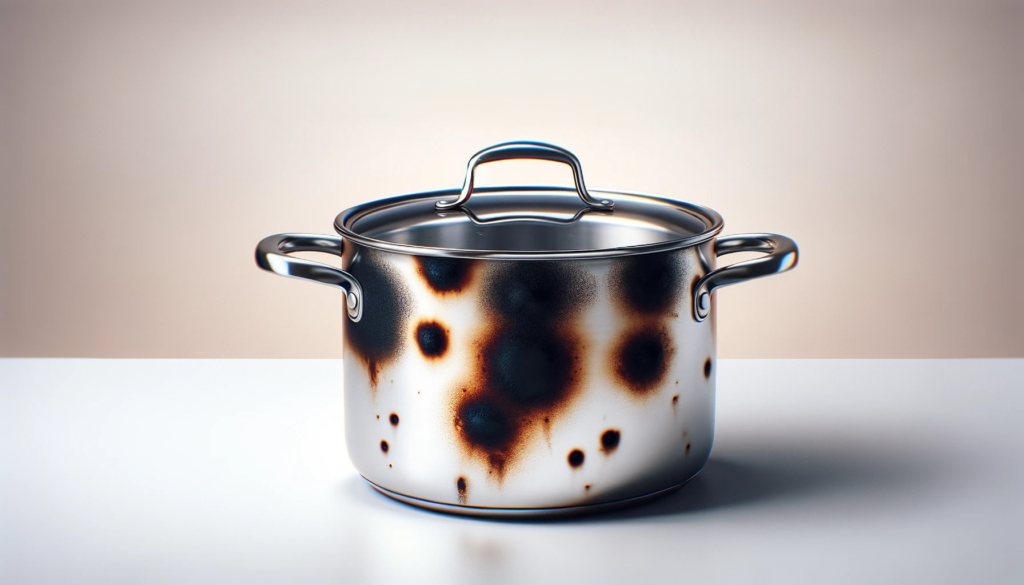
Heating empty stainless steel cookware too high or for too long can breakdown the protective chromium oxide layer on its surface. This layer is what makes stainless steel stainless by preventing interaction with oxygen.
Once this layer degrades from extreme heat, the exposed steel begins directly interacting with environmental oxygen. The result is surface oxidation and the formation of black spots or stains.
Putting very cold foods or liquids into extremely hot stainless steel cookware can also damage the protective chromium layer. This leads to uneven heating and expansion that fractures the protective surface.
Any exposed bare metal will allow direct oxygen interaction and oxidation.
To prevent overheating issues, pan temperature should be reduced to medium or medium-low before adding any cold ingredients. Cookware should also never be heated when completely dry.
Some oil, water, or cooking grease should be present to moderate pan surface temperature. Food should also be added once cookware reaches optimal cooking temperature to prevent further heating of an empty pan.
Avoid putting very cold items into hot pans whenever possible.
How Overheating Damages the Protective Layer
Stainless steel owes its stainless, anti-corrosive properties to the presence of a thin chromium oxide passivation layer on the surface. By reacting with environmental oxygen, the underlying steel forms this protective layer just microns thick.
However, excessive heat can destabilize the chromium oxide layer over 300 ̊C, especially without any cooking medium or ingredients present to disperse the heat. Empty overheated stainless steel cookware can reach temperatures beyond this threshold very quickly.
Without a moderating cooking medium to absorb and conduct away excessive heat, the metal itself simply continues rising in temperature. Unchecked, temperatures keep increasing well past intended cooking range to between 400-500 ̊C.
Extended exposure above 300 ̊C degrades the oxidation properties that maintain the protective chrominum oxide layer though. Once compromised, direct oxygen interaction with the exposed steel beneath leads to progressive discoloration, spots, and more extensive burning or blackening marks.
Preventing Damage from Overheating
Maintaining proper cooking temperatures is central to preventing degradation of stainless steel’s protective qualities. Cookware should be taken off direct heat and temperatures reduced to medium or medium low settings before adding cold foods or liquids.
Even a small amount of oil, cooking fat or liquid during preheating keeps temperatures moderated. Allowing cookware to reach optimal cooking temperatures once a cooking medium is present also ensures no further empty overheating.
Gradual heating steps without sudden temperature shocks prevents the chromium oxide layer from fracturing. Careful direct stove top heating control prevents excessive temperatures in the first place.
4. Cleaning Methods and Chemicals
Cleaning stainless steel cookware with abrasive scouring pads, abrasive cleanser powders, or harsh chemical cleaners can damage the protective surface over time.
Scrubbing with rough pads or abrasive cleansers physically scratches the smooth cookware surface. These microscopic scratches slowly remove the chromium oxide layer and expose the bare stainless steel metal underneath.
Chemical cleaners containing chlorine, ammonia, or bleach can also breakdown down the protective chromium layer, especially if allowed to soak on the surface for extended time.
Once scratches or chemical damage expose the underlying steel, oxidation from air and moisture results in black spots and stains. The key is to only clean stainless steel with non-abrasive, soft scrub pads, dishcloths, or brushes.
Any cleanser used should be mild, without harsh chemicals listed on the label. Cookware should also be rinsed thoroughly after washing, with no soaking for extended periods in cleaning solutions.
How Abrasives Damage the Surface Over Time
While stainless steel demonstrates substantial scratch resistance compared to other reactive metals, the buildup of microscopic damage erodes performance and appearance over time.
Abrasives like metal scouring pads, scrub powders, oven cleaners and even some nylon brushes all can wear away the smooth protective chromium layer. Enough accumulated scratches exponentially increase exposed steel surface area where further corrosion begins.
Pitting, discoloration and permanent black stains or spots reflect the ongoing erosion and exposure of metal from these abrasions.
Progressive abrasion comes from the simple fact that stainless steel fabrication methods deposit the chromium oxide passivation layer on top of the underlying steel alloy. This layer protects the surface but remains vulnerable itself to grinding, pitting or chemical removal.
Choosing gentle scrub pads like soft sponges, microfiber cloths and soft-bristle brushes minimizes unnecessary scratching during cleaning while still lifting away grime. More abrasion simply removes more protective finish and accelerates visible damage accumulation.
Preventing Damage from Harsh Chemical Cleaning
Powerful chemicals like chlorine bleach, hydrochloric acid solutions and alkaline drain openers all can dissolve protective metal oxides given enough exposure. Improper soaking or contact times allow chemicals to degrade the microscopic chromium layer on stainless steel cookware surfaces as well.
Chlorine-based cleaners interact strongly with chromium, stripping this finish even with minimal direct contact. More dilute concentrations found in dishwasher detergents still degrade this protective barrier over repeat washing cycles.
Limiting soak times and rinsing thoroughly after cleaning prevents chemical erosion. Any use of corrosive cleansers should involve immediate rinsing.
Harsher chemical cleaners should be avoided entirely unless following usage directions very precisely for the shortest effective contact.
Conclusion
In conclusion, black spots on stainless steel cookware occur due to four main reasons – metal transfer from utensils, mineral deposits from water and food, overheating cookware, and using abrasive cleaning tools and chemicals.
Being aware of these causes and taking steps like using non-metal utensils, cleaning after each use, avoiding empty overheating, and using gentle scrub pads or cloths can help prevent the annoying discoloration. With proper care, your stainless steel pots and pans can stay looking shiny and new for years.
